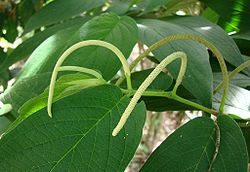| Piperales Temporal range: | |
|---|---|
 | |
| Piper aduncum | |
| Scientific classification | |
| Kingdom: | Plantae |
| Clade: | Tracheophytes |
| Clade: | Angiosperms |
| Clade: | Magnoliids |
| Order: | Piperales Bercht. & J.Presl [2] |
| Families | |
| Synonyms [3] | |
| |
Piperales is an order of flowering plants (4,170 recognized species). It necessarily includes the family Piperaceae but other taxa have been included or disincluded variously over time. Well-known plants which may be included in this order include black pepper, kava, the many Peperomias, pepper elder, lizard's tail, birthwort, and wild ginger. [4] The two perianthless families Piperaceae and Saururaceae are mainly herbaceous plants possessing highly reduced flowers. [5] [6]
